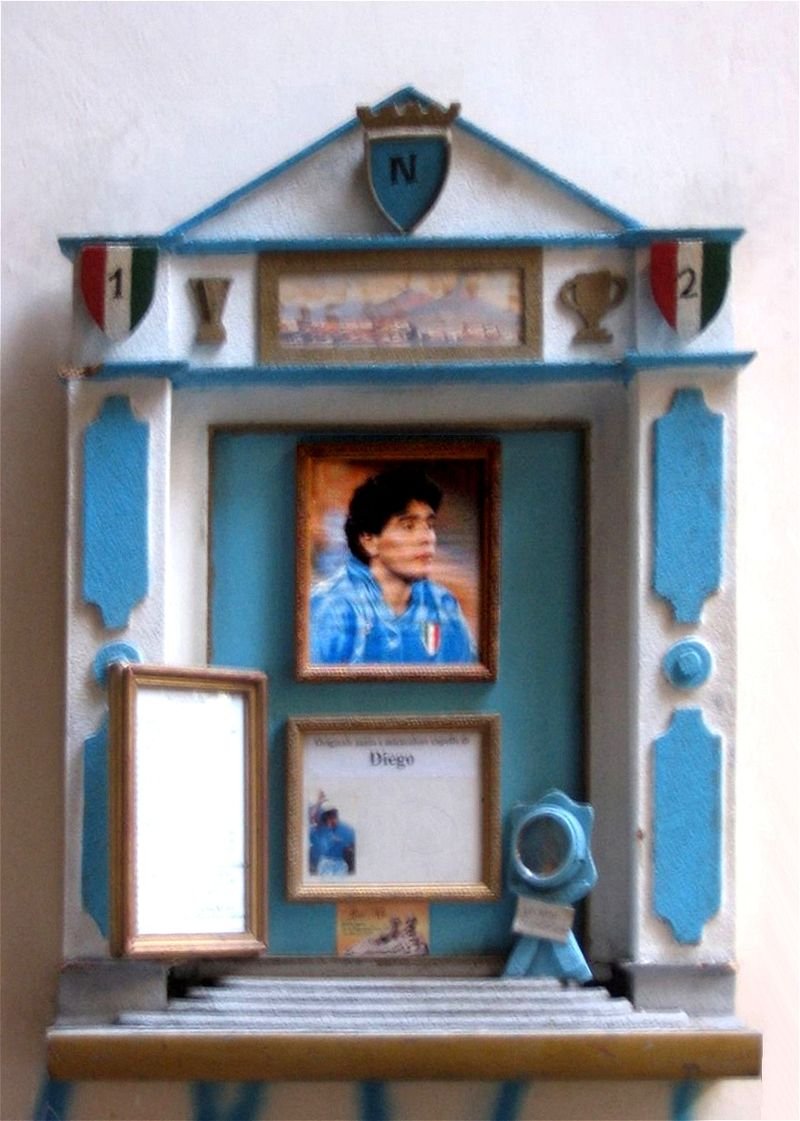This article was written by combining my (poor) knowledge of the English language with the help of an automatic translator. Please, forgive any mistakes you may have. Thank you.

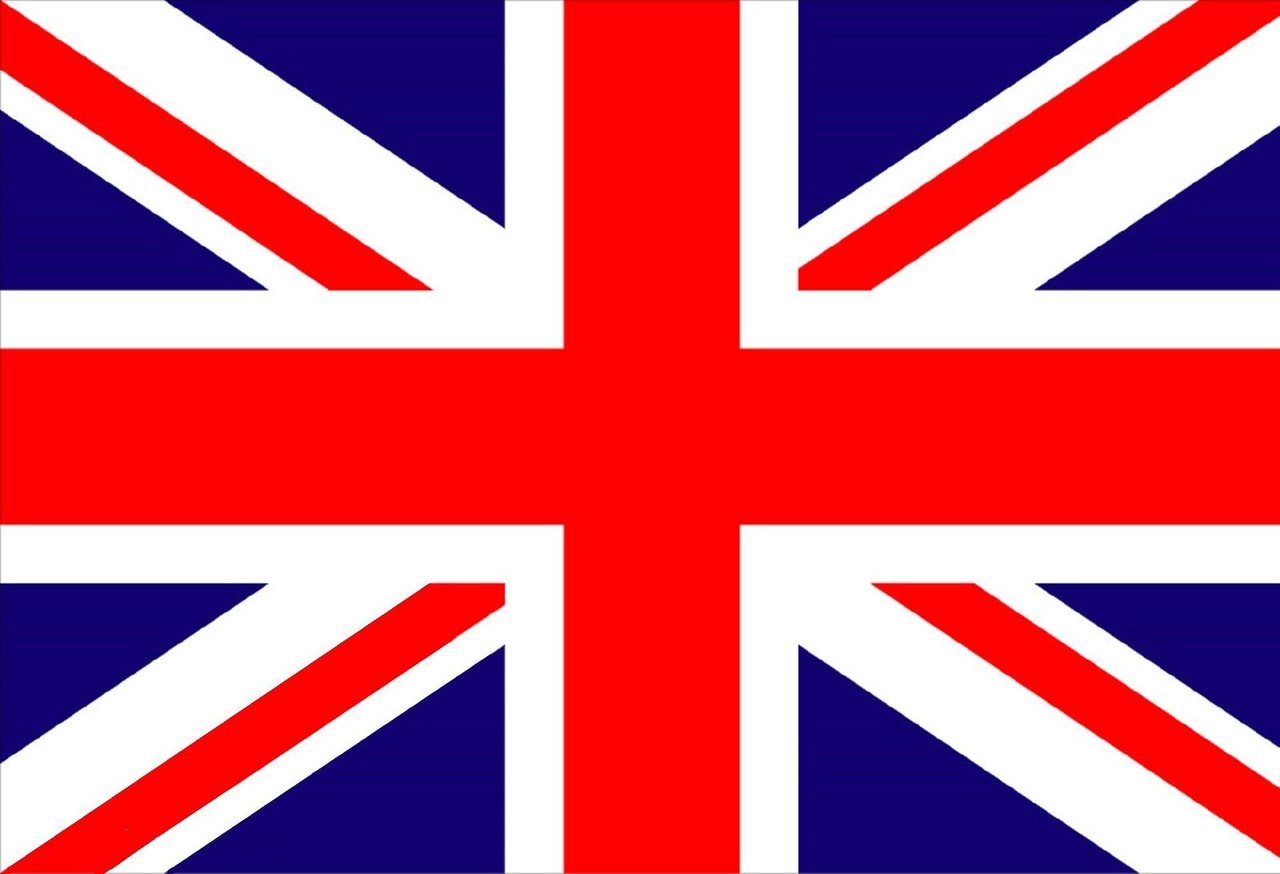
Anyone in the world who has talked about football, at least once in their life, cannot fail to know the deeds of Diego Armando Maradona, the one who many define as the greatest player in history. Diego passed away yesterday, in his home in Tigre, a suburb of his beloved Buenos Aires, due to a cardio-circulatory arrest. He had entered the hospital three weeks ago, due to a head operation made necessary for the removal of edema, but his body, tried by years of excesses and addictions, evidently did not resist this last blow and little was prompt interventions by medical staff served.
With this article I intend to pay homage to el pibe de oro, retracing his Italian history, which is the period of greatest splendor of his entire exciting career.
The arrival in Naples and the presentation
On June 30, 1984, after a few weeks of tight negotiations, spent between raises and blitzes by the then president Corrado Ferlaino, Napoli deposits the contract of Diego Armando Maradona in the League of Serie A, snatched from Barcelona for a record amount of 14 billion lire.
The thriller of the Argentine champion's arrival in Italy was solved only on the last day of the market, despite the fact that Ferlaino could not yet have the signed contract, at the official closure of the negotiations: the number one of the Neapolitan company, strong of the verbal agreement with the player and with Barcelona, he deposited in the League at first only an empty envelope, replacing it during the night with the complicity of a security guard.
Diego joined a large group of champions, such as Zico, Falcao, Platini, who already populated Italian football, at the time the most important in the world, and was presented five days later at San Paolo in front of eighty thousand people in raptures, who paid a symbolic ticket costing a thousand lire to see the then twenty-three year old champion dribble in the middle of the field.
Good evening Neapolitans, I am very happy to be here with you ...
These are the first embarrassed words of the new Neapolitan number ten, which perhaps at that moment did not imagine that it would become the icon of an entire city even in the years to come.
The first season (1984/85 championship)
Despite the enthusiasm of the Neapolitans and the premises with which the Argentine champions moved to Napoli on the eve of the 1984/85 championship, Maradona is unable to affect that much, while maintaining a good achievement average , which leads him to close the season with 17 total goals (14 in the league and three in Coppa Italia).
Napoli closes the season with a disappointing eighth place, consequently not qualifying even for the European cups. In Italian cup the path of the Neapolitans is just as modest, and after the passage of the preliminary rounds in the summer, they are eliminated in the round of 16 in the double challenge with Milan.
The second season and the world title (1985/86 championship)
While not improving his personal score, which ended at the end of the season with 13 overall goals (11 goals in the league and 2 in the Italian Cup), Maradona helps the team to significantly increase their quality of play, finishing the championship in third place place.
Napoli, entrusted to Ottiavio Bianchi, begins to lay the foundations for the construction of a sensational team, but of the Neapolitan season, and of the Argentine champion in particular, to remain as a symbol the free kick with the which Maradona gives his team, on the ninth day, the historic victory over Juventus, destined to become Italian champion at the end of the year.
Even today, almost forty years later, no one can explain how Diego was able to give such a trajectory to the ball, which has become unstoppable for the goalkeeper Tacconi.
But it is from the 1986 Mexican World Cup that the legend of Maradona begins to be known all over the world: the Napoli player drags his national team to the conquest of the world title thanks to unforgettable performances and goals, like the one called "the goal of the century", made in the quarter-finals against England (pictured).
The first Scudetto and the victory of the Italian Cup (1986/87 championship)
Fresh from the world success, Maradona performs a real sporting miracle, dragging his Napoli to the conquest of the first championship in its history, as well as the third Coppa Italia, won by obtaining the success in all thirteen matches played.
The Argentine champion's goals at the end of the season will be seventeen (10 in Serie A and 7 in Coppa Italia), but Diego will be decisive in many games thanks to his assists and plays, including the victory obtained on the ninth matchday on the field of the Juventus champion of Italy (the last victory of Napoli in Turin was thirty-seven years earlier).
On 10 May 1987, after the 1-1 draw with Fiorentina, the celebration of the Neapolitan people can explode, who have now elected Maradona as their undisputed idol and popular representative.
The first time in the European Champions Cup (1987/88 championship)
The year following that of the historic Scudetto also sees the first participation of Maradona and Napoli in the Champions Cup, although the European inexperience will have a decisive weight in the elimination of the Campania team in the first round, by the Real Madrid.
However, the biggest disappointment for el pibe de oro and for all his teammates will take place in the league, led until February, and incredibly lost in the last few days, in favor of Milan coached by Arrigo Sacchi ; various hypotheses were made about the fall of Napoli at the time, including a mutiny by part of the team against the coach and threats received by the players from the Camorra due to clandestine betting, without however could ever collect evidence.
Despite the disappointment, Diego will close the year with excellent personal results, setting the scoring record of his Italian experience, with twenty-one goals in thirty-nine games overall.
The first European trophy (1988/89 championship)
In the year of the Serie A victory of the record-breaking Inter, coached by Giovanni Trapattoni, Napoli will be the protagonist of an exciting ride in Uefa Cup, which culminated in the final victory over Stuttgart. Maradona will contribute with three goals, all scored on penalties (against Paok, Juventus and in the final), to the European triumph of the Neapolitans, even if this will be the least year in the league prolific, with only nine signatures to his credit.
Over a month after winning the trophy, the Napoli will also play the final of the Coppa Italia, at the end of an excellent course in which Maradona will score six times; however Ottavio Bianchi's team, after winning the first leg final 1-0 at San Paolo, will be defeated in the second leg 4-0 by Sampdoria.
The second Scudetto and the controversies in the Italian World Cup (1989/90 championship)
Despite having been forced to miss the first five league games due to physical problems, Maradona becomes the protagonist of the second championship won by Napoli, disputing, in the 1989/90 season, his best championship in Serie A from a realization point of view, in which he finds the way to goal sixteen times in twenty-eight games. Diego appears in the eyes of the world as the brightest star of the world championship played in the summer in Italy, and despite the mediocre game of his national team, he is decisive in reaching the final.
Maradona becomes the protagonist of the semifinal, played right in Napoli against Italy, already on the eve, after the invitation addressed to the local public not to support the Italian national team, citing reasons of racism:
They ask you to be Italian now that they need it, and this bothers me a lot ...
The tears of the Olimpico final of Roma, after the defeat of his national team in the final against Germany, ideally mark the end of the love story between the Argentine ace and Italy.
The last trophy and farewell to Italy (1990/91 championship)
The Italian super cup, won at the start of the season against Juventus, is destined to remain Diego Armando Maradona's last joy in Italy. Already heavily addicted to drugs, his performances on the pitch will get worse and worse and his behaviors intolerable, between unjustified absences and delays in training. The most striking case occurs in October, when Maradona does not leave with the team for the trip to Moscow in the Champions Cup, reaching the team only the next day with a private plane and thus contributing to its elimination.
The positivity to cocaine, in the anti-doping control of March 17, 1991, marks the end of the Italian experience of the Argentine number ten, who will play a game again pending the official result. He will be transferred to Sevilla at the end of the season, where he will play at the end of the disqualification.
The end of a love story
Maradona leaves his Naples, to the dismay of an entire city, the night between 1 and 2 April, returning only 14 years later, on the occasion of the farewell match to football in Ciro Ferrara, in 2005.
In his Italian period he scored 115 goals in 259 games, becoming the strongest footballer in the world, but he has also often been at the center of extra-football news, due to his disreputable frequentations in the world of organized crime and his relationships cheating. Abandoned by her favorite son, Napoli will no longer be able to return to the levels of the Diego period, often having to relegate its ambitions to less prestigious goals.
However, the Campania capital has never forgotten it, as evidenced by the murals and altars sown in the city. After his death, a moving wake spontaneously gathered in the streets of Naples, which will soon name the city's stadium after the man who made it famous around the world.
Read Also:
- Napoli - Milan: the best matches of the past
- Fan Stories, ep. 5 (Juventus - Cagliari 2-0)
- Serie A review, 8th round
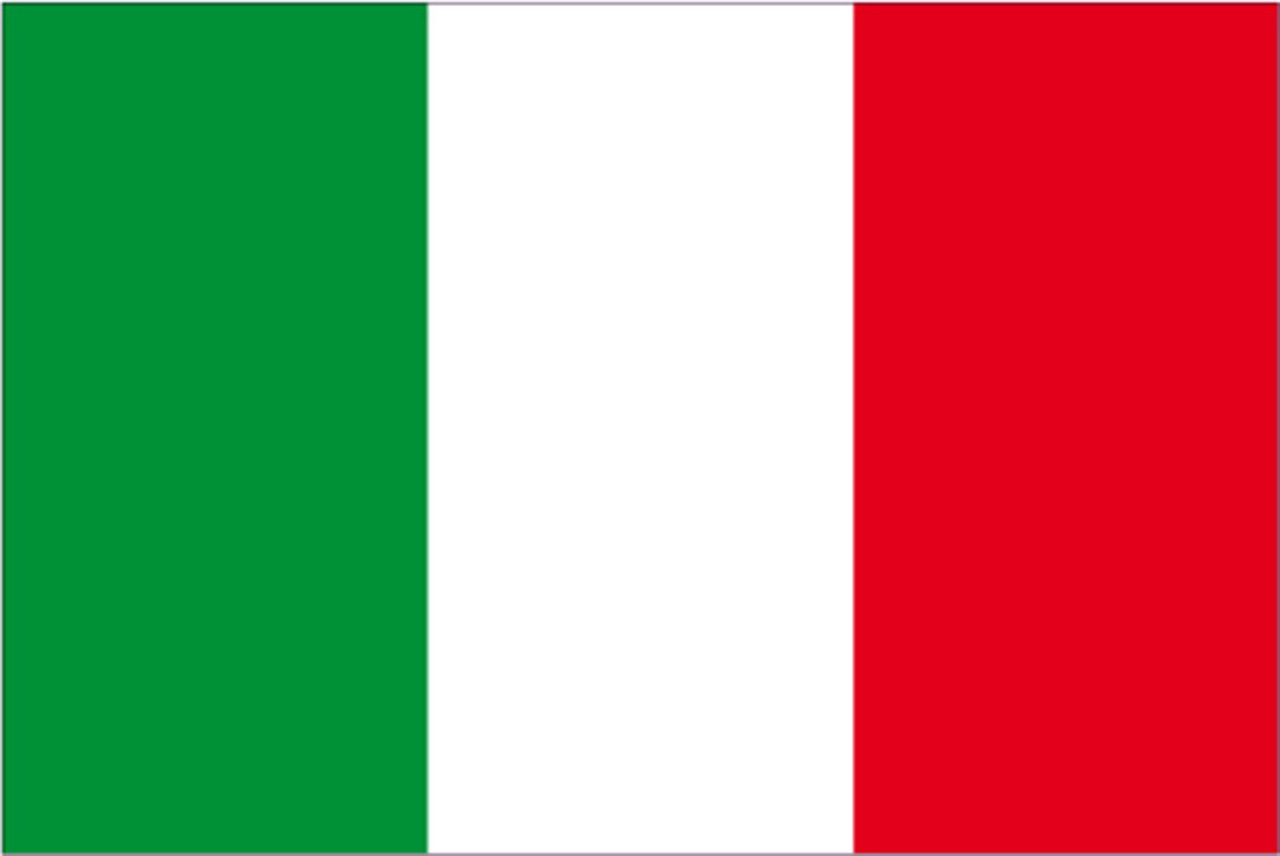
Chiunque al mondo abbia parlato di calcio, almeno una volta nella vita, non può non conoscere le gesta di Diego Armando Maradona, colui che molti definiscono il più grande giocatore della storia. Diego se ne è andato ieri, nella sua casa di Tigre, sobborgo dell'amata Buenos Aires, per un arresto cardio-circolatorio. Era entrato in ospedale tre settimane fa, a causa di un'operazione alla testa resasi necessaria per la rimozione di un edema, ma il suo corpo, provato da anni di eccessi e dipendenze, non ha evidentemente resistito a quest'ultimo colpo e a poco sono valsi i tempestivi interventi del personale medico.
Con questo articolo intendo omaggiare el pibe de oro, ripercorrendo la sua storia italiana, ovvero il periodo di maggior splendore di tutta la sua entusiasmante carriera.
L'arrivo a Napoli e la presentazione
Il 30 Giugno 1984, dopo alcune settimane di trattative serrate, trascorse tra rilanci e blitz da parte dell'allora presidente Corrado Ferlaino, il Napoli deposita in Lega il contratto di Diego Armando Maradona, strappato al Barcellona per una cifra record di 14 miliardi di lire.
Il giallo dell'approdo del fuoriclasse argentino in Italia, venne risolto soltanto nell'ultimo giorno di mercato, nonostante Ferlaino non potesse ancora disporre, alla chiusura ufficiale delle trattative, del contratto firmato: il numero uno della società partenopea, forte dell'accordo verbale col calciatore e con il Barcellona, depositò in Lega in un primo momento solo una busta vuota, sostituendola nella notte con la complicità di una guardia giurata.
Diego si unì ad una folta schiera di campioni, come Zico, Falcao, Platini, che già popolavano il calcio italiano, all'epoca il più importante del mondo, e venne presentato cinque giorni dopo al San Paolo davanti ad ottantamila persone in visibilio, che pagarono un simbolico biglietto dal costo di mille lire per vedere l'allora ventitreenne fuoriclasse palleggiare in mezzo al campo.
Buonasera napoletani, sono molto felice di essere qui con voi...
Queste le prime imbarazzate parole del nuovo numero dieci partenopeo, che forse in quel momento non immaginava che sarebbe diventato l'icona di un'intera città anche negli anni a venire.
La prima stagione (campionato 1984/85)
Nonostante l'entiusiasmo dei napoletani e le premesse con le quali il fuoriclasse argentino si trasferisce a Napoli alla vigilia del campionato 1984/85, Maradona non riesce ad incidere più di tanto, pur mantenendo una buona media realizzativa, che lo porta a chiudere la stagione con 17 reti totali (14 in campionato e tre in Coppa Italia).
Il Napoli chiude la stagione con un deludente ottavo posto, non qualificandosi di conseguenza nemmeno per le coppe europee. In Coppa Italia il cammino dei partenopei risulta altrettanto modesto, e dopo il passaggio dei turni preliminari in estate vengono eliminati negli ottavi di finale nella doppia sfida con il Milan.
La seconda stagione e il titolo mondiale (campionato 1985/86)
Pur non migliorando il proprio score personale, chiuso a fine stagione con 13 segnature complessive (11 reti in campionato e 2 in Coppa Italia), Maradona aiuta la squadra ad aumentare sensibilmente la propria qualità di gioco, terminando il campionato al terzo posto.
Il Napoli, affidato ad Ottiavio Bianchi, comincia a porre le basi per la costruzione di una squadra sensazionale, ma della stagione partenopea, e del fuoriclasse argentino in particolare, rimarne come simbolo la punizione con la quale Maradona regala alla sua squadra, alla nona giornata, la storica vittoria sulla Juventus, destinata a diventare campione d'Italia a fine anno.
Ancora oggi, a distanza di quasi quarant'anni, nessuno sa spiegarsi come Diego abbia potuto imprimere una traiettoria del genere al pallone, divenuto imprendibile per il portiere Tacconi.
Ma è dal mondiale messicano del 1986 che la leggenda di Maradona comincia ad essere conosciuta in tutto il mondo: il giocatore del Napoli trascina infatti la sua nazionale alla conquista del titolo mondiale grazie a prestazioni e goal indimenticabili, come quello definito "il goal del secolo", realizzato nei quarti di finale all'Inghilterra (nella foto).
Il primo scudetto e la vittoria della Coppa Italia (campionato 1986/87)
Reduce dal successo mondiale, Maradona compie un vero e proprio miracolo sportivo, trascinando il suo Napoli alla conquista del primo campionato della sua storia, oltre che della terza Coppa Italia, vinta ottenendo il successo in tutti e tredici gli incontri disputati.
Le reti del fuoriclasse argentino al termine della stagione saranno diciassette (10 in Serie A e 7 in Coppa Italia), ma Diego risulterà decisivo in molte partite grazie ai suoi assist e alle sue giocate, compresa la vittoria ottenuta alla nona giornata sul campo della Juventus campione d'Italia (l'ultima vittoria del Napoli a Torino risaliva a trentasette anni prima).
Il 10 Maggio 1987, dopo il pareggio 1-1 con la Fiorentina, può pertanto esplodere la festa del popolo napoletano, che ha ormai eletto Maradona a proprio idolo indiscusso e rappresentante popolare.
La prima volta in Coppa dei Campioni (campionato 1987/88)
L'anno successivo a quello dello storico scudetto, vede anche la prima partecipazione di Maradona e del Napoli in Coppa dei Campioni, sebbene l'inesperienza europea avrà un peso decisivo nell'eliminazione della squadra campana al primo turno, per opera del Real Madrid.
Tuttavia, la delusione maggiore per el pibe de oro e per tutti i suoi compagni avverrà in campionato, condotto in testa fino a Febbraio, e perso incredibilmente nelle ultime giornate, in favore del Milan allenato da Arrigo Sacchi; sulla caduta del Napoli si fecero all'epoca diverse ipotesi, tra le quali un ammutinamento di parte dello spogliatoio contro l'allenatore e le minacce ricevute dai giocatori da parte della camorra per un giro di scommesse, senza tuttavia che se ne potessero mai raccogliere le prove.
Nonostante la delusione, Diego chiuderà l'anno con eccellenti risultati personali, realizzando il record di segnatura della sua esperienza italiana, con ventuno goal in trentanove partite complessive.
Il primo trofeo europeo (campionato 1988/89)
Nell'anno della vittoria in Serie A dell'Inter dei record, allenata da Giovanni Trapattoni, il Napoli si rende protagonista di un cavalcata entusiasmante in Coppa Uefa, culminata con la vittoria in finale sullo Stoccarda. Maradona contribuisce con tre reti, segnate tutte su calcio di rigore (contro Paok, Juventus e in finale), al trionfo europeo dei partenopei, anche se in campionato questo risulta l'anno meno prolifico, con solo nove segnature all'attivo.
Oltre un mese dopo la conquista del trofeo, il Napoli disputerà anche la finale di Coppa Italia, al termine di un ottimo percorso nel quale Maradona andrà a segno sei volte; tuttavia la squadra di Ottavio Bianchi, dopo aver vinto 1-0 la finale di andata al San Paolo, verrà sconfita al ritorno 4-0 dalla Sampdoria.
Il secondo scudetto e le polemiche nel mondiale italiano (campionato 1989/90)
Nonostante fosse stato costretto a saltare le prime cinque partite di campionato, per problemi fisici, Maradona si rende protagonista del secondo scudetto conquistato dal Napoli, disputando, nella stagione 1989/90, il suo miglior campionato di Serie A sotto un punto di vista realizzativo, nel quale trova la via del goal sedici volte in ventotto partite. Diego appare agli occhi del mondo come la stella più splendente del mondiale disputato in estate in Italia, e nonostante il gioco mediocre della sua nazionale, risulta decisivo nel raggiungimento della finale.
Maradona diventa protagonista della semifinale, giocata proprio a Napoli contro l'Italia, già alla vigilia, dopo l'invito rivolto al pubblico locale di non supportare la nazionale italiana, adducendo motivi di razzismo:
Vi chiedono di essere italiani adesso che ne hanno bisogno, e questo mi dà molto fastidio...
Le lacrime della finale dell'Olimpico di Roma, dopo la sconfitta della sua nazionale in finale contro la Germania, segnano idealmente la fine della storia d'amore tra l'asso argentino e l'Italia.
L'ultimo trofeo e l'addio all'Italia (campionato 1990/91)
La supercoppa italiana, conquistata all'inizio della stagione contro la Juventus, è destinata a rimanere l'ultima gioia di Diego Armando Maradona in Italia. Già pesantemente dipendente dalla droga, le sue prestazioni in campo diverranno sempre peggiori e i suoi comportamenti intollerabili, tra assenze non giustificate e ritardi in allenamento. Il caso più eclatante accade ad Ottobre, quando Maradona non parte con la squadra per la trasferta a Mosca di Coppa dei Campioni, raggiungendo la squadra solo il giorno dopo con un aereo privato e contibuendo così alla sua eliminazione.
La positività alla cocaina, nel controllo anti-doping del 17 Marzo 1991, segna la fine dell'esperienza italiana del numero dieci argentino, che giocherà ancora una partita in attesa dell'ufficialità del risultato. Verrà ceduto a fine stagione al Siviglia, dove giocherà al termine della squalifica.
La fine di una storia d'amore
Maradona abbandona la sua Napoli, tra lo sgomento di un'intera città, la notte tra l'1 e il 2 aprile tornandoci solo 14 anni dopo, in occasione della partita d'addio al calcio di Ciro Ferrara, nel 2005.
Nel suo periodo italiano ha realizzato 115 reti in 259 partite, diventando il più forte calciatore del mondo, ma è anche spesso stato al centro delle cronache extra-calcistiche, per via delle sue frequentazioni poco raccomandabili nel mondo della malavita organizzata e per le sue relazioni fedifraghe. Abbandonata dal suo figlio prediletto, Napoli non riuscirà più a tornare ai livelli del periodo di Diego, dovendo spesso relegare le proprie ambizioni a traguardi di minor prestigio.
Tuttavia il capoluogo campano non l'ha mai dimenticato, come testimoniano i murales e gli altarini seminati in città. Dopo la sua morte una commovente veglia funebre si è radunata spontaneamente per le vie di Napoli, che presto intitolerà il suo stadio all'uomo che l'ha resa famosa nel mondo.
Leggi anche:
- Napoli - Milan: le più belle sfide del passato
- Le avventure di un tifoso, ep. 5 (Juventus - Cagliari 2-0)
- Serie A review, 8^ giornata
- Italyco Pallone III, ep.3 - Guest star @spiceboyz



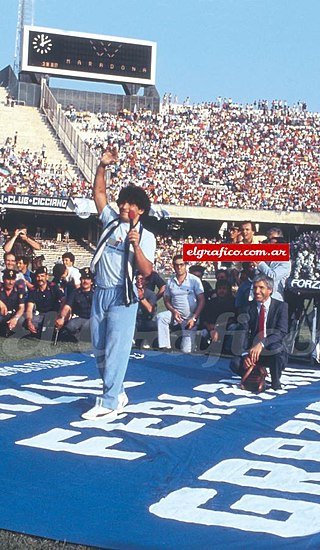

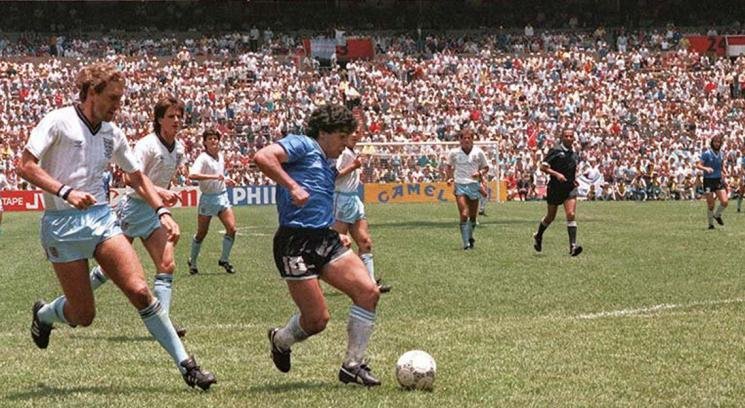
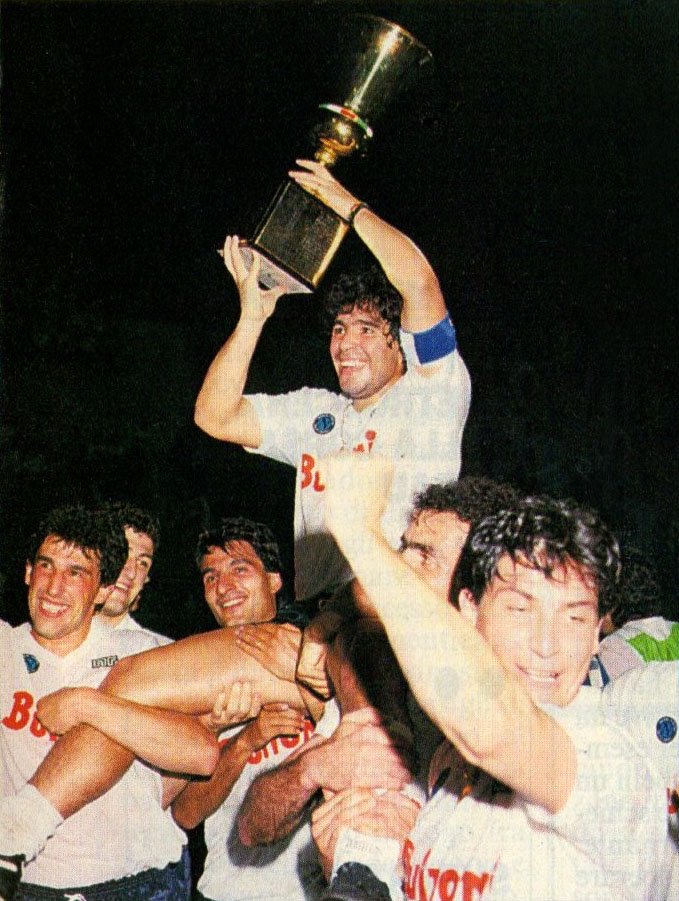
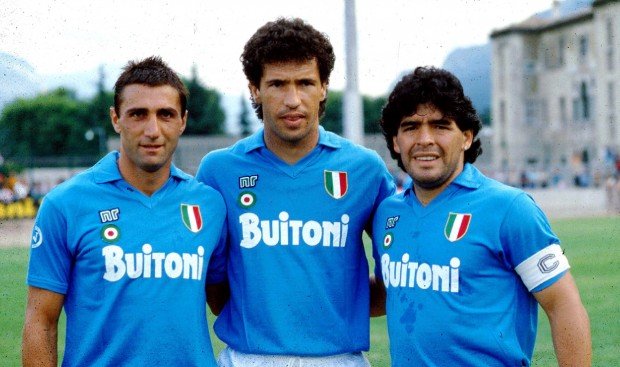
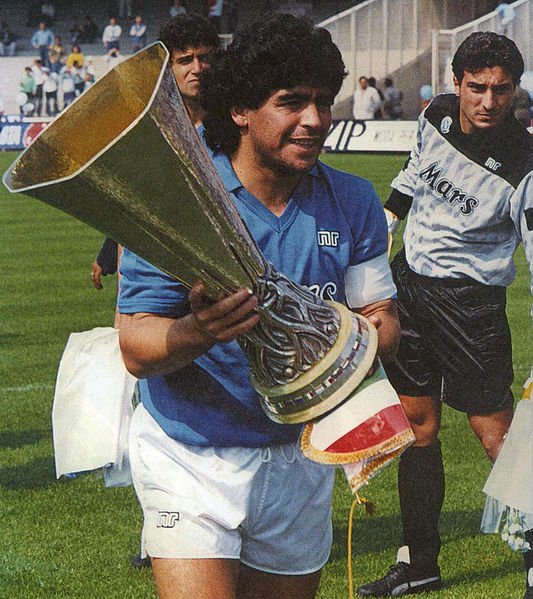
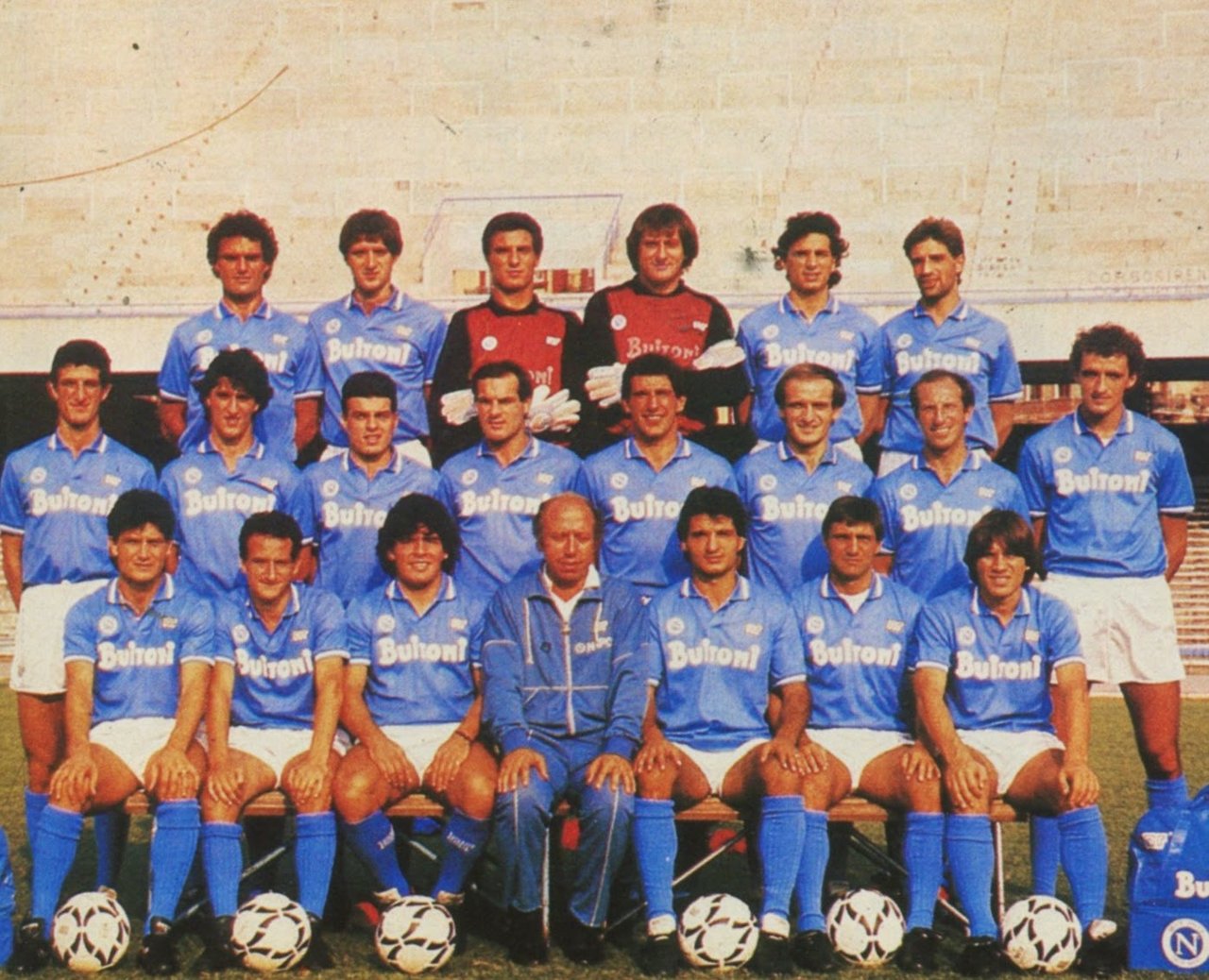
_-_Supercoppa_italiana_1990.jpg)
